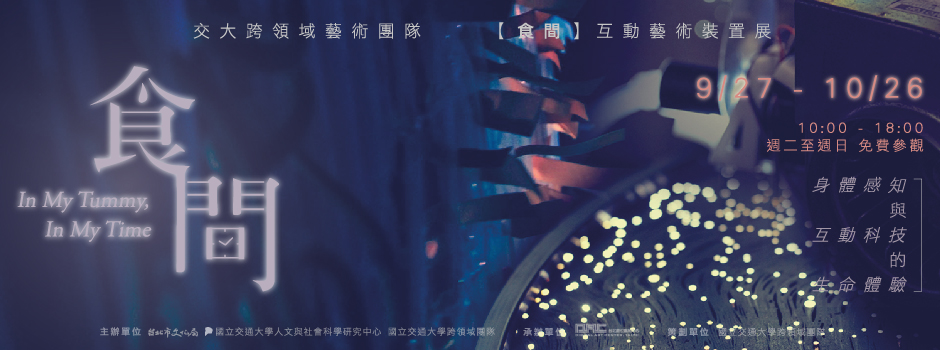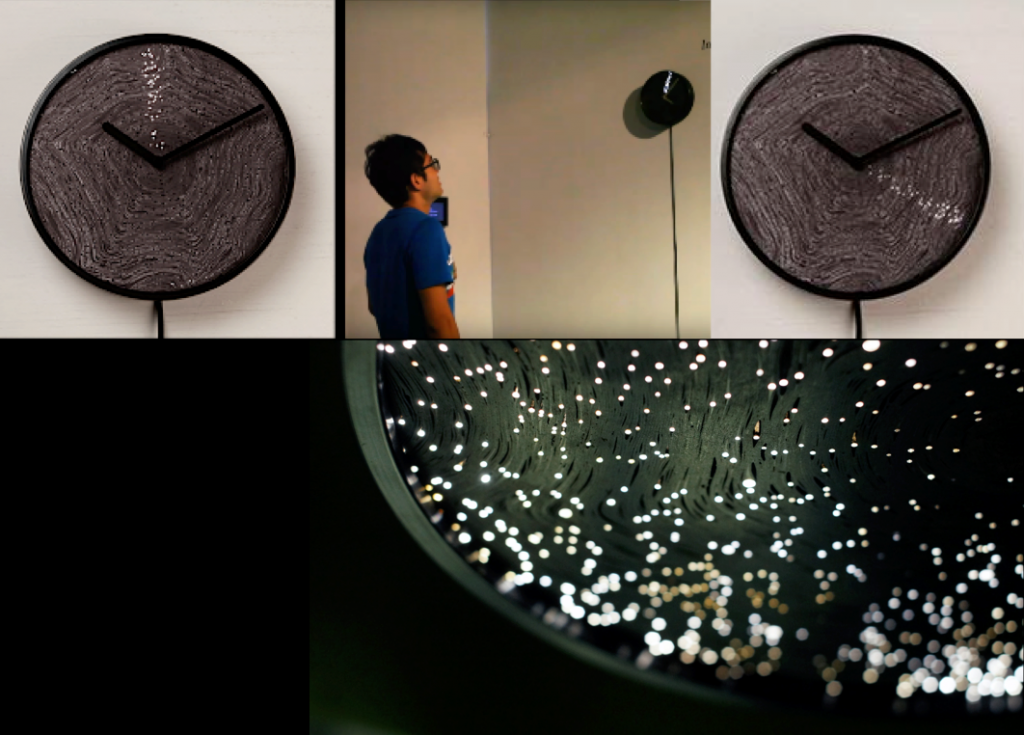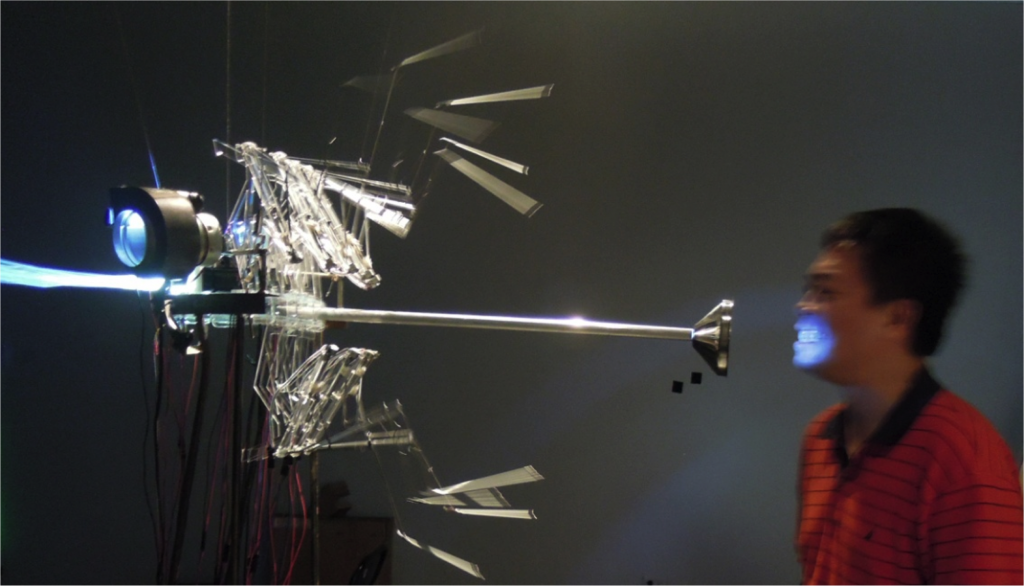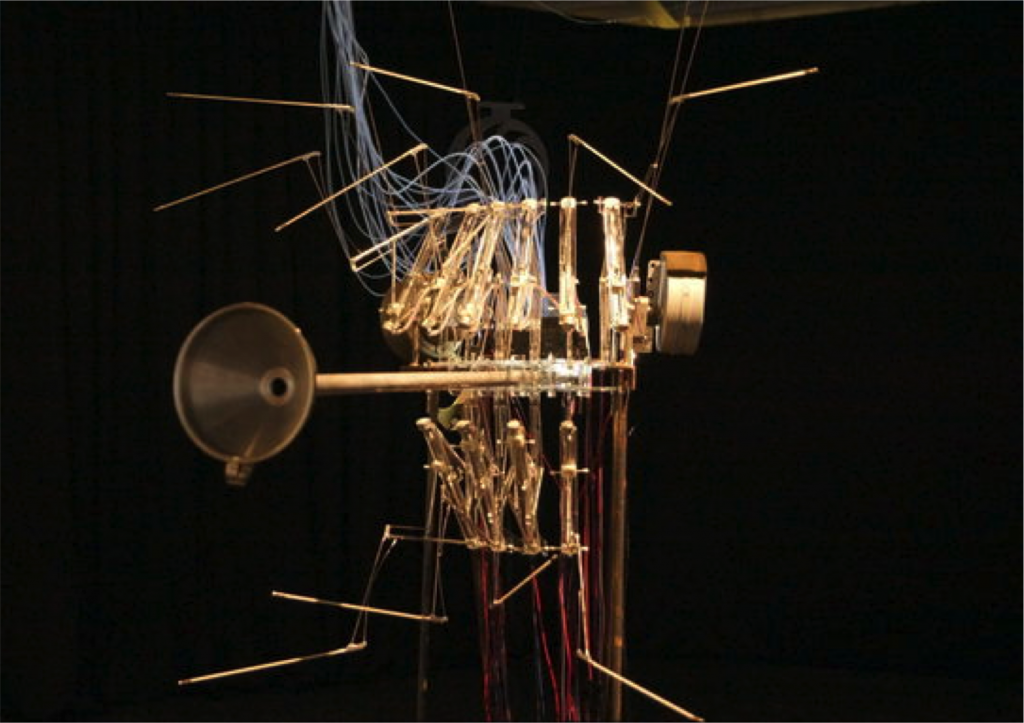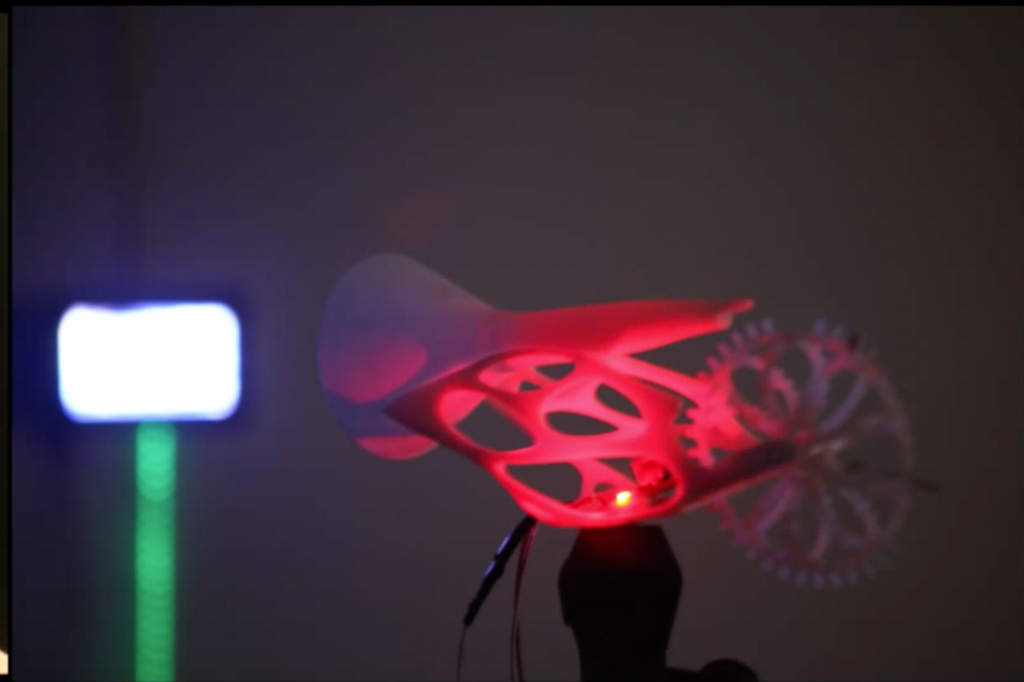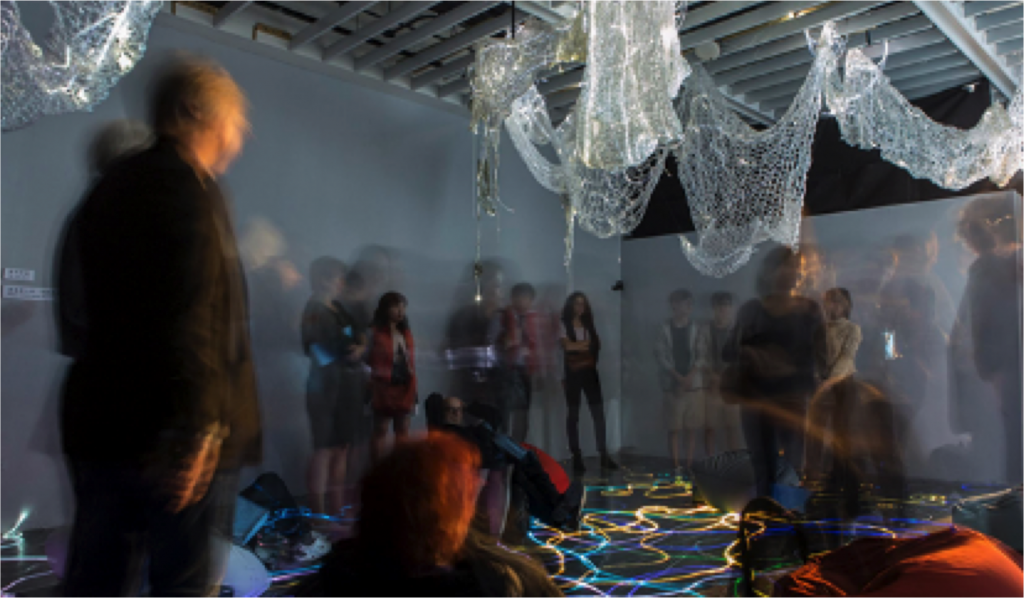《食間‧時間》In My Tummy, In My Time
2014 跨領域藝術團隊 台北數位藝術中心展覽
*《食間 In My Tummy In My Time》開幕
*《食間 In My Tummy In My Time》藝術家訪談 賴雯淑 董昭民教授
*《食間 In My Tummy In My Time》藝術家訪談 馬席彬 教授
*《食間 In My Tummy In My Time》藝術家訪談 郭家宏-內外時鐘
*《食間 In My Tummy In My Time》藝術家訪談 葉韋鉦〈入口〉
*《食間 In My Tummy In My Time》藝術家訪談 蘇育民-食微化/時微化
*《食間 In My Tummy In My Time》藝術家訪談 陳昱榮 歐俐廷-癢分
*《食間 In My Tummy In My Time》藝術家訪談陳韻竹 卜繁宇 林宇涵 邱品惠 鍾國君 林佑勳-剩餘價值
《食間‧時間》In My Tummy, In My Time
交大跨領域藝術團隊 TransArt NCTU
DAC 台北數位藝術中心
111 台北市士林區福華路180號
展期|2014 年 09/27 ~ 10/26
開幕茶會| 09/27 (六) 14:00
導覽| 09/27 (六) 14:30
座談活動| 09/27 (六) 15:00~16:00
與談人:
許素朱 Su-Chu Hsu (國立臺北藝術大學電影與新媒體學院 院長)、
林珮淳 Pey-Chwen Lin (國立台灣藝術大學多媒體動畫藝術學系(所)專任教授、數位藝術實驗室主持人)、
鄭建文 Chien-Wen Cheng (國立台北科技大學互動設計系助理教授)
Digital Art Center, Taipei
No.180, Fuhua Rd., Shihlin Dist., Taipei 111, Taiwan
Exhibition Period : 27 Sep.-26 Oct. 2014
Opening Reception : 27 Sep. (Sat.)14:00
Guided Tour : 27 Sep. (Sat.)14:30
Discussion : 27 Sep. (Sat.)15:00-16:00
展覽簡介 Introduction
以食物在人體器官中的形變與質變為發想起點,消化過程作為隱喻,透過物質的消解和轉化,探討藝術作品如何透過形式與媒材的特質,讓觀眾的感知與內外時間一起流動,進而改變身體經驗。藝術家將器官與其執行的多重功能拆解開來,擷取其中的關鍵特質,賦予想像和詮釋。作品沒有具體的生理器官意象,而是將其功能特質或概念解構、抽象化;觀眾的聲音、呼吸、心跳、動作被當作食物,餵養展場中的作品,經過咀嚼、碎裂、輸送、分解等過程引發一聯串的反應,使原有的質性產生轉化、形變之互動效果。作品引領觀眾走進一個概念性的過程,經由奇幻的藝術語彙與內隱式的數位感應科技,提供觀眾另一種未被定義的身體感知經驗,在內外時間的交互之間,體會身體作為介面的藝術經驗和存在感。
展覽由交通大學應用藝術、音樂、建築三所師生所組成的交大跨領域藝術團隊師生精心策劃,由德國裝置藝術家Hans W. Koch擔任藝術和技術咨詢,共創作六件裝置藝術作品──《內外鐘 Clock Inside Out》、《入口/入口Feeding/Entrance》、《食微化/時微化Micro Food/Micro Time》、《胃裡派對Belly Party》、《癢分Itchy Nutrition》,及《剩餘價值The Remains of the Day》。作品使用多種媒材與手法,除採用影像、聲音、光及紅外線感應器來擷取外顯訊號外,也與清華大學電機系馬席彬教授研究團隊合作,採用其研發之生理感應器,取得身體內部的訊息,經過不同的編譯,轉為實體裝置的機械影音控制訊號,最終以可感訊號再生,試圖以當代科技結合藝術創作來提供辯證生存意義的路徑。
Treating the formal and qualitative changes of foods in human organs as the point of departure, and invoking a metaphor of the digestive process to represent the decomposition and transformation of matter, the team explores how artworks, by harnessing the qualities of different forms and media, shape the viewers’ perceptions amidst the time passing in the organs and that elapsing in the exhibition venue where the viewers experience unique physical sensations. Separating the organs per se from their multiple functions, the artists extract the distinguishing characteristics of the organs and leave them to the viewers’ imagination and interpretation. The exhibited works do not provide concrete physiological imagery of the digestive system but deconstruct and abstract the organs’ characteristics and functions. The viewers’ voices, breaths, heartbeats, and motions become the various foods for the works and therefore set off a chain reaction of mastication, fragmentation, transmission, and decomposition. The chain reaction, along with the viewers’ involvement, leads to the transformation and deformation of matters. With artistic vocabulary and covert digital sensors, these works guide the viewers into a conceptual process which brings them an indescribable sensation. By transforming their own bodies into the interface, the viewers also gain an artistic experience and a sense of existence amidst the time passing in the organs and that elapsing in the real world.
The exhibition is curated by the interdisciplinary team “transArt NCTU” from the National Chiao Tung University. It consists of the faculties and students from the Institutes of Applied Arts, Music, and Architecture at NCTU. German new media artist Hans W. Koch serves as the artistic/technical consultant. The exhibition presents six installations, including “Clock Inside Out,”“Feeding/Entrance,” “Micro Food/Micro Time,” “Belly Party,” “Itchy Nutrition,” and “The Remains of the Day.” To create these works, the team employed various media and techniques such as images, sounds, light, and infrared sensors for capturing explicit signals. In addition, the artists also derived the information circulating in human bodies from the physiological sensor developed by prof. Ma Hsi-Pin’s team at the Department of Electrical Engineering, NTHU. The sensor is able to transform the information into mechanical and audio-visual control-messages for physical devices and then regenerate them in the form of sensible signals. In sum, transArt NCTU team tries to pioneer an approach to the reflection on the meaning of existence through the combination of technology and art.
作品介紹 Descriptions Of Works
作品1《內外時鐘/Clock Inside Out》
《內外時鐘》傳遞的訊息是「時空轉換旅程的起點」,當觀眾看到時鐘的瞬間,就進入了有別於外在世界的時間和空間,雖然時針和分針仍然隨著世界的時間在運轉,但秒針是依著觀眾的心跳節奏來前進,我們想提問的是:在「食間」內的流連駐足,如何改變我們的存在感?在食間和時間的內外轉換之間,我們的感知經驗究竟有甚麼改變?
This work signifies the unfolding journey of temporal and spatial transformation. When the audience encounters the “Clock Inside Out”, they have fallen into a zone different from the external world. Though the hour hand and the minute hand move accordingly with time, the second hand moves accordingly with the audience’s heartbeat. The question for the audience to ponder is: during our presence in the exhibition — “In My Tummy, In My Time”, how has our sense of existence been changed? How have our physical sensations and experiences been shaped in this peculiar zone?
作品2《入口/入口Feeding/Entrance》
以口腔的功能進行發想,試圖將口腔咀嚼的過程,透過互動的方式轉化並再現。此一機械拼貼裝置,以觀眾發出的聲音作為食物,透過觀眾的「餵食」,啟動機械運作並產生機械聲響,猶如反覆咀嚼的過程,並帶給觀者抽象的咀嚼意象與想像。
“Feeding/Entrance”
Treating the function of oral cavity as the point of departure, the artistseeks to transform and represent the process of mastication through the interaction between the viewers and this work. The collaged mechanical installation takes the viewers’ voices as the foods that bring it into noisy operation. The whole process resembles iterated mastication and leaves an abstract imagery to the viewers’ imagination.
作品3《食微化/時微化 Micro Food/Micro Time》
延續物質被絞碎的意象,此作品利用光纖編織成互動裝置,將觀者帶往下一個展覽空間,藉由吹氣來啟動互動機制,讓觀眾可以感受吞嚥及推送食物的過程,其運動模式既是一種具象的生理模擬,也是一種抽象的伸縮開合形變。
“Micro Food/Micro Time”
Drawing on the imagery of masticated foods, the artist weaves optical fibers into this interactive installation that leads the viewers to the next exhibition room. The viewers are allowed to activate the interactive mechanism by blowing air on the work and thereby observe the process of swallowing and pushing foods through the esophagus. The motion pattern of the work not only represents a concrete physiological mechanism but also indicates an abstract, flexible deformation.
作品4《胃裡派對/Belly Party》
從胃的生理功能出發,萃取出「消化」與「停留」兩個主要概念。由上而下的水滴狀裝置是模擬食物分子被胃液包覆的形態,胃部的收縮蠕動則轉化成虛擬影像,投影在水滴球體上,以此視覺化胃的消化作用。進場觀眾人數經由即時運算成為改變影像色調及速度的數據,當人數激增時,會引發猶如暴飲暴食所導致的消化不良後果;腳步聲也會透過收音設備成為飄蕩在胃部空間中的游離分子,整個場域因觀眾的參與和停留,成為充滿生命動態的有機體。
“Belly Party”
The artists extract two major concepts, namely “digestion” and “retention” from the physiological functions of the stomach and then visualize them in this work. The vertically installed, water-drop shaped sphere simulates the nutrient molecules cladded by gastric juices. The artists turn the stomach’s traction and peristalsis into virtual images and project them onto the water-drop shaped sphere. This approach visualizes the process in which food is digested. The real-time computation converts the number of viewers to the data that dictate the hue and hopping frequency of the projected images. When the number of viewers increases rapidly, the work will produce an effect similar to the dyspepsia caused by binge eating. Besides, the audio receiver transforms the sound of the viewers’ footsteps into ionized molecules in the stomach. In sum, the exhibition room becomes a vigorous organism as a consequence of the viewers’ participation and temporary stay.
作品5《癢分/Itchy Nutrition》
以小腸蠕動、吸收養分的概念出發,將觀眾視為被研磨分解的食物,羊腸般的走道為投影互動空間,作品欲呈現的是觸感變化、視覺解構和聽覺互動的「食間/時間」流程。
“Itchy Nutrition”
Based on the concepts of intestinal peristalsis and absorption, theartists take the viewers as the decomposed nutrients and the narrow, winding path as the interactive space for projection. In this work, the artists attempt to present the tactile, visual, and auditory senses that interact and vary with different types of time.
作品6.《剩餘價值/The Remains of the Day》
在人體器官中,大腸吸收小腸餘留下來的營養及水份,象徵著剩餘價值。觀者在進入作品時,配帶呼吸及心跳的感應器。藉由人的呼吸、心跳能讓光線產生指示及對話,而有機狀的編織物暗喻著觀眾被器官所包覆。觀眾在進入空間後,由感應器接收其生理訊號,讓光的顏色、明暗、頻率隨之改變,帶來視覺上的獨特經驗和感受。消化系統的裝置至此將告一段落,觀眾可以在此沈澱這趟樣貌多變的感官與心靈旅程,反思屬於自己的價值。
The large intestine absorbs the residual nutrition and water from the matter moved through the small intestine. The residues symbolize the surplus value. Before the viewers enter the room in which the work is exhibited, they will be equipped with breath- and pulse-sensors. The sensors are able to instruct the lighting installation to point out directions and therefore engage in dialogues with the viewers. The organic texture of the work implies that the viewers are encapsulated by the organ. After the viewers enter the exhibition room, the sensors will receive their physiological signals that change the color, brightness, and frequency of light, and thereby bring the viewers peculiar feelings and sensations. The journey through the digestive system ends with this work. The viewers are allowed to linger in the exhibition venue and review the multi-faceted sensory and spiritual journey. By doing so, they may reflect on their own value amidst the conversion between the inner and outer worlds.
【參展藝術家】
應藝所 賴雯淑 Wen-Shu Lai、謝啟民Chi-Min Hsieh、陳宜惠Yi-Huei Chen、楊婷婷Ting-Ting Yang、盧冠廷Guan-Ting Lu、周宣Shiuan Chou、邱品惠Ping-Hui Chiu、陳韻竹Yun-Tsu Chen、林宇涵Yu-Han Lin、卜繁宇Fan-Yu Bu、郭家宏Chia-Hung Kuo
音樂所 董昭民Chao-Ming Tung、陳昱榮Yu-Jung Chen、歐俐廷Li-Ting Ou
建築所 侯君昊June-HaoHou、蘇育民Yu-Min Su、葉韋鉦Wei-Cheng Yeh
【藝術和技術咨詢 Artistic and Technical Consultant】
Hans W. Koch
【《內外時鐘/Clock Inside Out》與《剩餘價值/The Remains of the Day》互動技術】
清華大學電機系感知應用研發團隊 NTHU EE Cognitive Applications R&D Group
馬席彬Hsi-Pin Ma, 黃柏鈞 Po-Chiun Huang, 莊嘉瑋Jia-Wei Jhuang, 陳泓劭 Hung-Shao Chen, 林佑勳 Yu-Hsun Lin, 陳易萱 Yi-Hsuan Chen, 鍾國君Kuo-Chun Chung, 盧彥丞 Yen-Chen Lu
【Participating Artists】
Institute of Applied Arts:
Wen-Shu Lai, Chi-Min Hsieh, Yi-Huei Chen, Ting-Ting Yang, Guan-Ting Lu, Shiuan Chou, Ping-Hui Chiu, Yun-Tsu Chen, Yu-Han Lin, Fan-Yu Bu, Chia-Hung Kuo
Institute of Music:
Chao-Min Tung, Yu-Jung Chen, Li-Ting Ou
Institute of Architecture:
June-Hao Hou, Wei-Cheng Yeh, Yu-Min Su
【Artistic/Technical Consultant】
Hans W. Koch
【Interactive Technology R&D for “Clock Inside Out” and “The Remains of the Day”】
NTHU EE Cognitive Applications R&D Group:
Hsi-Pin Ma, Po-Chiun Huang, Jia-Wei Jhuang, Hung-Shao Chen, Yu-Hsun Lin, Yi Hsuan Chen, Kuo-Chun Chung, Yen-Chen Lu
